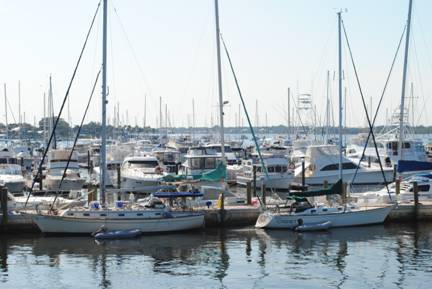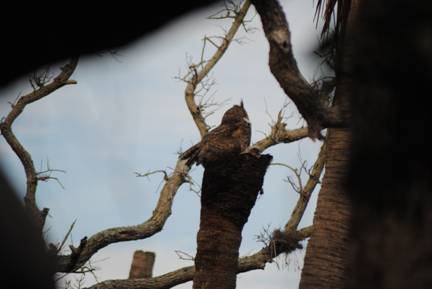 View from
Zarafina looking towards the marina
View from
Zarafina looking towards the marina
We always intended to spend the weekend here, but the
weather forecast for the next couple of days is for windy weather (gusting up
to 30mph tomorrow) and so we have decided to stay put until Wednesday at least.
Of course windy weather and choppy seas brought home to me one of the disadvantages of mooring a quarter of mile
from the marina. Whereas the prospect of falling out of the dingy in calm
waters and temperatures of 76 degrees didn’t seem so very awful…the trip over a choppy
sea on a grey day isn’t much fun.
 We visited the beach on Friday
and I spent a blissful hour collecting shells. They were literally piled
up on the high water line. We then visited the House of Refuge (1876),
the last remaining example of ten houses built in response to the continual
loss of life and property along the sparsely populated east coast of
Florida. Previously if a shipwrecked sailor made it to shore they often
died a long and slow death of starvation and thirst. All ten houses were
built to exactly the same design: four rooms (bedroom, dining room, sitting
room and kitchen) with stabling below. The keeper rode along the beach
looking for survivors, although single-handedly they could offer little in the
way of active rescue and only had basic first aid supplies. Initially the
Keepers were single men and it must have been a lonely vigil however later on
there were married couples and families living there. Procedures dictated
that signs with the distance and a hand pointing in the direction of the Refuge
had to be planted along the beach. The Keepers were responsible for
submitting regular reports and wreck records with details of the vessel, cargo,
crew numbers, description of the circumstances and an account of the number of
meals and per-head costs. On one occasion there were wrecks on
consecutive days with some 23 survivors being accommodated, requiring the
Keeper’s wife to utilise the biggest vessel to hand - her washing tub -
to cook sufficient food. One ship was carrying mahogany and the locals
weren’t above salvaging it from the beach and using it in their homes.
We visited the beach on Friday
and I spent a blissful hour collecting shells. They were literally piled
up on the high water line. We then visited the House of Refuge (1876),
the last remaining example of ten houses built in response to the continual
loss of life and property along the sparsely populated east coast of
Florida. Previously if a shipwrecked sailor made it to shore they often
died a long and slow death of starvation and thirst. All ten houses were
built to exactly the same design: four rooms (bedroom, dining room, sitting
room and kitchen) with stabling below. The keeper rode along the beach
looking for survivors, although single-handedly they could offer little in the
way of active rescue and only had basic first aid supplies. Initially the
Keepers were single men and it must have been a lonely vigil however later on
there were married couples and families living there. Procedures dictated
that signs with the distance and a hand pointing in the direction of the Refuge
had to be planted along the beach. The Keepers were responsible for
submitting regular reports and wreck records with details of the vessel, cargo,
crew numbers, description of the circumstances and an account of the number of
meals and per-head costs. On one occasion there were wrecks on
consecutive days with some 23 survivors being accommodated, requiring the
Keeper’s wife to utilise the biggest vessel to hand - her washing tub -
to cook sufficient food. One ship was carrying mahogany and the locals
weren’t above salvaging it from the beach and using it in their homes.
We then visited a small museum housing the eclectic
collections of a father and son named Elliot who between them held a number of
invention patents including the first machine to tie a knot and what passed for
an automated addressing machine. The addressing machine held a pile of
metal frames each with a stencilled wax paper address label, which were
mechanically inked and rolled to produce envelopes…and the reason I know
so much about it is that I swear
I saw the same method utilised in my early working life, I just can’t
remember which firm. There were twenty or so vintage cars and several
motor bikes including a very early Harley Davison, which was really not much
more than a motorised bicycle (and no chrome!).

 Dodging the showers we next went
to the Oceanographic Centre and I got to hand feed the stingrays! There
were few visitors and so we were the only ones to join the very knowledgeable
volunteer for the Nature Trail. He told us all about the different types
of mangrove and how they purify the water, even though the detritus on the
bottom may make the water seem coloured. He pointed out a Great
Horned Owl nesting site and Melv managed to get a photograph of the
female. These owls have a wing span of 5ft!!
Dodging the showers we next went
to the Oceanographic Centre and I got to hand feed the stingrays! There
were few visitors and so we were the only ones to join the very knowledgeable
volunteer for the Nature Trail. He told us all about the different types
of mangrove and how they purify the water, even though the detritus on the
bottom may make the water seem coloured. He pointed out a Great
Horned Owl nesting site and Melv managed to get a photograph of the
female. These owls have a wing span of 5ft!!
Driving around the area we passed the first of three
Garden Centres. At the first we noticed the large area given over to rows
and rows of exotic (to us) and healthy looking green palm trees (about four
feet high) but at the next two even the palms lining the entrance drive were
brown and I thought to myself, well that’s not a very good
advertisement. However when we got closer it was apparent the venture had
closed down and – presumably – the owners had handed over the keys
and walked away leaving the stock where it stood. According to a radio
report I heard, the same thing is happening with citrus orchards however there
is a big problem because the untreated trees get diseased or bugs and these
spread to adjoining commercial orchards.




